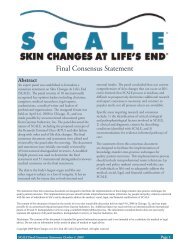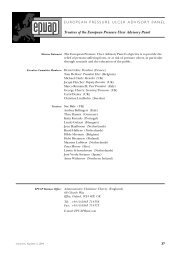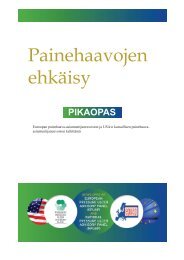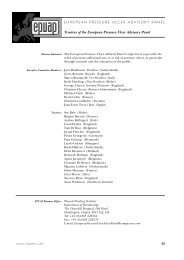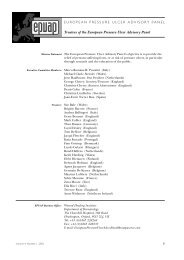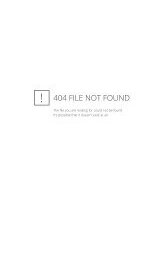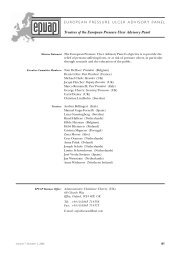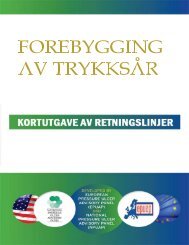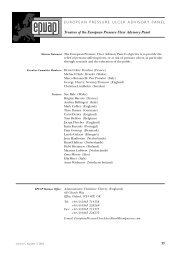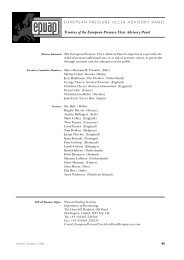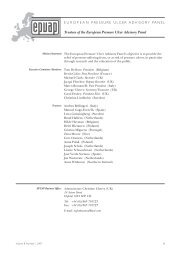EPUAP Review 10.1.indd - European Pressure Ulcer Advisory Panel
EPUAP Review 10.1.indd - European Pressure Ulcer Advisory Panel
EPUAP Review 10.1.indd - European Pressure Ulcer Advisory Panel
You also want an ePaper? Increase the reach of your titles
YUMPU automatically turns print PDFs into web optimized ePapers that Google loves.
PRESSURE ULCER PREVENTION GUIDELINES<br />
3. Inspect skin regularly for signs of redness in individuals identified as<br />
being at risk of pressure ulceration. The frequency of inspection may<br />
need to be increased in response to any deterioration in overall condition.<br />
(Strength of Evidence = B)<br />
Ongoing assessment of the skin is necessary to detect early signs of<br />
pressure damage.<br />
4. Skin inspection should include assessment for localized heat, oedema<br />
or induration (hardness), especially in individuals with darkly pigmented<br />
skin. (Strength of Evidence = C)<br />
Localized heat, oedema and induration have all been identified as<br />
warning signs for pressure ulcer development. As it is not always<br />
possible to see signs of redness on darkly pigmented skin these<br />
additional signs should be used for assessment.<br />
5. Ask individuals to identify any areas of discomfort or pain that could<br />
be attributed to pressure damage. (Strength of Evidence = C)<br />
A number of studies have identified pain as a major factor for individuals<br />
with pressure ulcers. In several studies there is also some indication<br />
that pain over the site was a precursor to tissue breakdown.<br />
6. Observe the skin for pressure damage due to medical devices.<br />
(Strength of Evidence = C)<br />
Many different types of medical devices have been reported as causing<br />
pressure damage (e.g., catheters, oxygen tubing, ventilator tubing,<br />
semirigid cervical collars, etc.).<br />
7. Document all skin assessments including details of any pain possibly<br />
related to pressure damage. (Strength of Evidence = C)<br />
Accurate documentation is essential to monitor the progress of the<br />
individual and to aid communication between professionals.<br />
SKIN CARE<br />
8. Do not turn the individual onto a body surface that is still reddened<br />
from a previous episode of pressure loading whenever possible.<br />
(Strength of Evidence = C)<br />
Redness indicates that the body has not recovered from the previous<br />
loading and requires further respite from repeated loading (See<br />
Etiology).<br />
9. Do not use massage for pressure ulcer prevention (Strength of<br />
Evidence = B)<br />
Massage is contra-indicated in the presence of acute inflammation and<br />
where there is the possibility of damaged blood vessels or fragile skin.<br />
Massage could not be recommended as a strategy for pressure ulcer<br />
prevention.<br />
10. Do not vigorously rub skin at risk for pressure ulceration. (Strength of<br />
Evidence = C)<br />
As well as being painful, rubbing the skin can also cause mild tissue<br />
destruction or provoke an inflammatory reaction, particularly in the<br />
frail elderly.<br />
11. Use skin emollients to hydrate dry skin in order to reduce risk of skin<br />
damage. (Strength of Evidence = B)<br />
Dry skin seems to be a significant and independent risk factor of<br />
pressure ulcer development.<br />
Volume 10, Number 1, 2009 7



